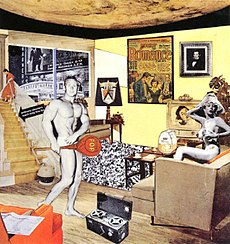Just what is it that make today’s homes so different, so appealing? by Richard Hamilton
 Pop art defined by Richard Hamilton is described as “popular,
transient, expendable, low cost, mass produced, young, witty, sexy, gimmicky,
glamorous, and big business.” One amazing work of his, Just what is it that make today’s homes so different, so appealing?, reflect
on the materialistic culture that society was transforming into.
Pop art defined by Richard Hamilton is described as “popular,
transient, expendable, low cost, mass produced, young, witty, sexy, gimmicky,
glamorous, and big business.” One amazing work of his, Just what is it that make today’s homes so different, so appealing?, reflect
on the materialistic culture that society was transforming into.
It
presents a modern apartment with a big muscle man holding a Tootsie Pop, and a half
dressed pin up girl. The analogy between the man and the woman inhabiting the
apartment is compared to Adam and Eve, where they are surrounded in the “consumer’s
paradise.” Materialistic goods produced from pop culture are incorporated into
the collage, such as a television, a nice vacuum, a Ford Emblem, a huge comic
book cover, a tape recorder, and other nice goodies.
 This was made during the time in which people everywhere
became mall shoppers, TV watchers, car drivers, etc. People were dropping
dollars to live a pretty awesome life. Another subject matter to be discussed
about this painting is that there is that moon hovering over the materialist
Adam and Eve. This is used to represent the fear of Communism during the 1950s.
This reference to outer space brings
attention to the informal “Space Race” between Russia and America, a rivalry
that would declare the more accomplished country to be the symbolic leader of
the world. The morale-boosting societal benefits and potential propitious
military advancements a space-related victory allowed for such a proposition.
This was made during the time in which people everywhere
became mall shoppers, TV watchers, car drivers, etc. People were dropping
dollars to live a pretty awesome life. Another subject matter to be discussed
about this painting is that there is that moon hovering over the materialist
Adam and Eve. This is used to represent the fear of Communism during the 1950s.
This reference to outer space brings
attention to the informal “Space Race” between Russia and America, a rivalry
that would declare the more accomplished country to be the symbolic leader of
the world. The morale-boosting societal benefits and potential propitious
military advancements a space-related victory allowed for such a proposition. An
important thing to point out with Hamilton, as well as other Pop artists, is
that they did not approach popular culture in an ironic way pointing out the “ugliness”
of urban life, or something along that category. The” looked at the world in which they lived
and examined the objects and images around them with intensity and penetration,
frequently making the viewer conscious of that omnipresence for the first time.”
An
important thing to point out with Hamilton, as well as other Pop artists, is
that they did not approach popular culture in an ironic way pointing out the “ugliness”
of urban life, or something along that category. The” looked at the world in which they lived
and examined the objects and images around them with intensity and penetration,
frequently making the viewer conscious of that omnipresence for the first time.”
History of Modern Art by
H. H. Arnason and Elizabeth C. Mansfield

No comments:
Post a Comment